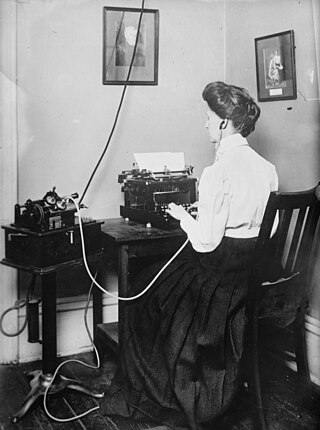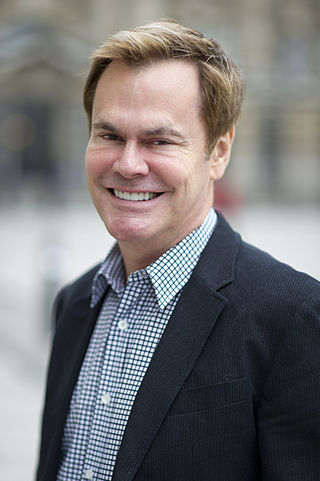
Machine translation is use of computational techniques to translate text or speech from one language to another, including the contextual, idiomatic and pragmatic nuances of both languages.

Novell, Inc. was an American software and services company headquartered in Provo, Utah, that existed from 1980 until 2014. Its most significant product was the multi-platform network operating system known as Novell NetWare. Novell technology contributed to the emergence of local area networks, which displaced the dominant mainframe computing model and changed computing worldwide.

Dictaphone was an American company founded by Alexander Graham Bell that produced dictation machines. It is now a division of Nuance Communications, based in Burlington, Massachusetts.
Computer-aided translation (CAT), also referred to as computer-assisted translation or computer-aided human translation (CAHT), is the use of software, also known as a translator, to assist a human translator in the translation process. The translation is created by a human, and certain aspects of the process are facilitated by software; this is in contrast with machine translation (MT), in which the translation is created by a computer, optionally with some human intervention.
Lernout & Hauspie Speech Products (L&H) was a Belgium-based speech recognition technology company, founded by Jo Lernout and Pol Hauspie, that went bankrupt in 2001 because of a fraud engineered by the management. The company was based in Ypres, Flanders, in what was later called Flanders Language Valley.
Nuance Communications, Inc. is an American multinational computer software technology corporation, headquartered in Burlington, Massachusetts, that markets speech recognition and artificial intelligence software.

Dragon NaturallySpeaking is a speech recognition software package developed by Dragon Systems of Newton, Massachusetts, which was acquired in turn by Lernout & Hauspie Speech Products, Nuance Communications, and Microsoft. It runs on Windows personal computers. Version 15, which supports 32-bit and 64-bit editions of Windows 7, 8 and 10, was released in August 2016.
Machine translation is a sub-field of computational linguistics that investigates the use of software to translate text or speech from one natural language to another.
A machine translation system developed at the University of Texas and at Siemens which ran on Lisp Machines.
IBM's Automatic Language Translator was a machine translation system that converted Russian documents into English. It used an optical disc that stored 170,000 word-for-word and statement-for-statement translations and a custom computer to look them up at high speed. Built for the US Air Force's Foreign Technology Division, the AN/GSQ-16, as it was known to the Air Force, was primarily used to convert Soviet technical documents for distribution to western scientists. The translator was installed in 1959, dramatically upgraded in 1964, and was eventually replaced by a mainframe running SYSTRAN in 1970.

Microsoft Translator or Bing Translator is a multilingual machine translation cloud service provided by Microsoft. Microsoft Translator is a part of Microsoft Cognitive Services and integrated across multiple consumer, developer, and enterprise products, including Bing, Microsoft Office, SharePoint, Microsoft Edge, Microsoft Lync, Yammer, Skype Translator, Visual Studio, and Microsoft Translator apps for Windows, Windows Phone, iPhone and Apple Watch, and Android phone and Android Wear.
Applications Technology (AppTek) is a U.S. company headquartered in McLean, Virginia that specializes in artificial intelligence and machine learning for human language technologies. The company provides both managed and professional services for natural language processing (NLP) technologies including automatic speech recognition (ASR), neural machine translation (MT), natural-language understanding (NLU) and neural speech synthesis. AppTek's automatic speech recognition covers over 45 languages and dialects. The neural MT engine covers over 1000 language pairs between languages.
Google Translator Toolkit was an online computer-assisted translation tool (CAT)—a web application designed to permit translators to edit the translations that Google Translate automatically generated using its own and/or user-uploaded files of appropriate glossaries and translation memory. The toolkit was designed to let translators organize their work and use shared translations, glossaries and translation memories, and was compatible with Microsoft Word, HTML, and other formats.

WikiBhasha is a multi-lingual content creation application for the online encyclopedia Wikipedia.

Bruce Wayne Bastian was an American computer programmer, businessperson, and philanthropist. He co-founded WordPerfect with Alan Ashton in 1978.

Alexander Waibel is a professor of Computer Science at Carnegie Mellon University and Karlsruhe Institute of Technology (KIT). Waibel’s research focuses on automatic speech recognition, translation and human-machine interaction. His work has introduced cross-lingual communication systems, such as consecutive and simultaneous interpreting systems on a variety of platforms. In fundamental research on machine learning, he is known for the Time Delay Neural Network (TDNN), the first Convolutional Neural Network (CNN) trained by gradient descent, using backpropagation.
The name MetaTexis is used for several software products developed by MetaTexis Software and Services. The main software products are MetaTexis for Word and the MetaTexis Server. MetaTexis for Word is a translation memory software, also called a Computer-assisted translation tool, that runs inside Microsoft Word. The MetaTexis Server is a server software for translation memories (TMs) and terminology databases (TDBs) that allows numerous translators to work with the same TMs and TDBs via LAN or Internet.
The following outline is provided as an overview of and topical guide to natural-language processing:

Lingotek is a cloud-based translation services provider, offering translation management software and professional linguistic services for web content, software platforms, product documentation and electronic documents.








